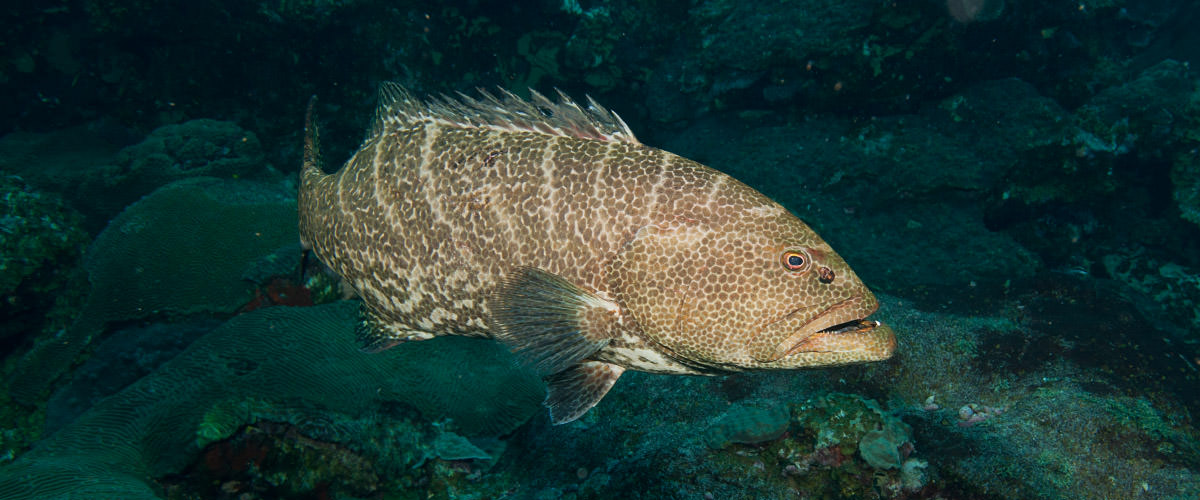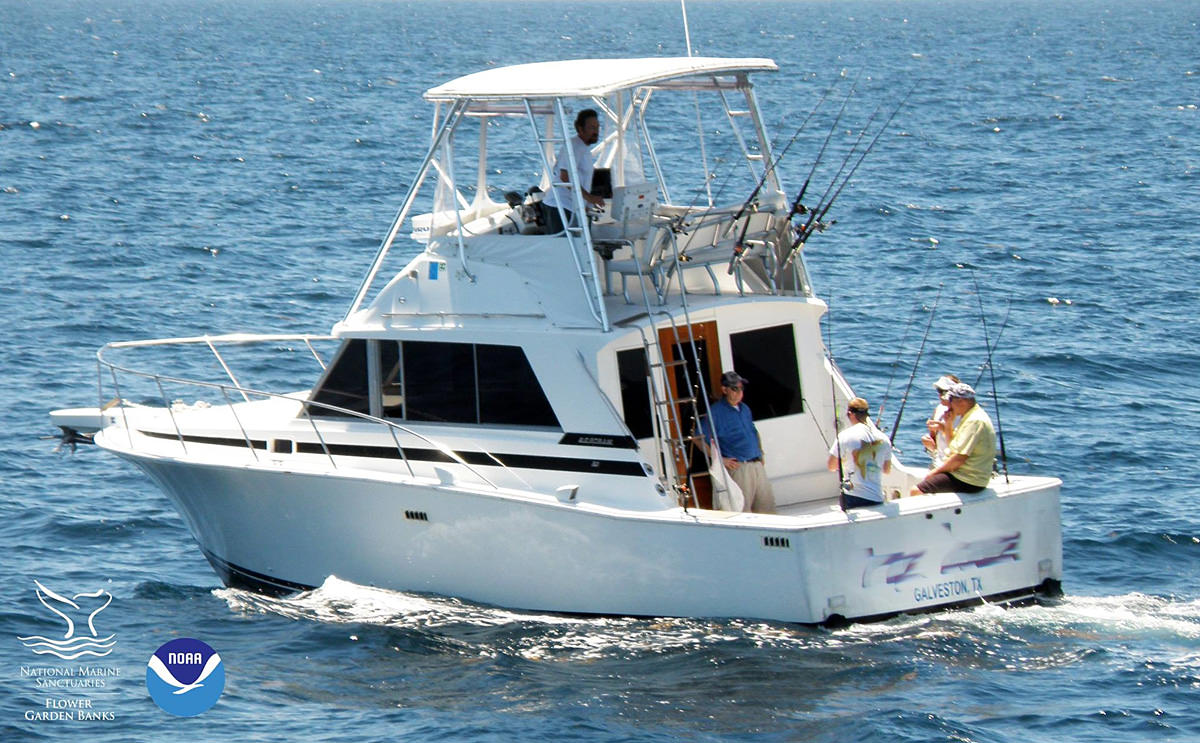Fishing Impacts
Flower Garden Banks

Why is it a concern?
The impacts of fishing and associated fishing activities in the sanctuary have not been well documented in Flower Garden Banks National Marine Sanctuary (FGBNMS).
Conventional hook and line fishing is the only form of fishing allowed in the sanctuary. However, illegal fishing by both commercial longliners and recreational spearfishermen has been reported. Lost or tangled bottom fishing gear has been found on numerous occasions, as well as discarded spear heads and lost spearguns.
Targeted fishing efforts, which are allowed under current regulations, could have detrimental impacts on snapper, grouper, mackerel, and jack populations, especially if directed at spawning aggregations. A bycatch effect could explain the apparent reduction in hammerhead shark numbers.
Observations by long-time divers within the sanctuary suggest that there has been a substantial decline in recent years in certain species of fish that are commonly targeted by fishers, including snapper, large groupers, and amberjacks. Technological advances in vessel design and equipment (e.g., high resolution multibeam maps, Global Positioning Systems, advanced fish finders, braided fishing line, etc.) have made it easier to find and catch fish in areas that were previously difficult to access.
Overview of Research
Past and current research in Flower Garden Banks National Marine Sanctuary has focused on characterization of fish assemblages in different benthic communities.
| Project Name | PI and contacts | Links |
|---|---|---|
|
East and West Flower Garden Banks Long-Term Monitoring |
Dr. Michelle Johnston, FGBNMS |
|
|
Stetson Bank Long-Term Monitoring |
Marissa Nuttall, FGBNMS |
|
|
Fish and Benthic Communities of the Flower Garden Banks National Marine Sanctuary: Science to Support Management |
Randy Clark, NOAA-NCCOS |
|
|
National Coral Reef Monitoring Program |
Randy Clark, NOAA-NCCOS |
Science Needs and Questions
- What is the spatial and temporal distribution of fishing effort in FGBNMS, by type, and what habitats and species are being targeted?
- What proportion of biomass of targeted and non-targeted species is removed in any given year?
- What species are being removed or impacted as bycatch? What is the mortality of non-targeted caught species if released?
- Does the removal rate exceed the replenishment rate for targeted and non-targeted species?
- Does the removal of particular fish affect the ecological influence of those species?
- How much does targeted fishing affect trophic structure?
- Is there a disproportionate removal of large adults of targeted species, and what is the effect on reproduction?
- Are there locations that constitute essential fish habitat (EFH) for certain species on the basis of requirements for shelter, breeding, feeding, or specific life history stages (e.g., spawning aggregations, wahoo, grouper, charcharinid sharks and hammerhead aggregations)?
- Do spawning aggregations occur and, if so, where?
- Why are wahoo aggregating in winter over the region’s banks, and does winter fishing make them vulnerable to overfishing?
- Are symbiotic relationships disrupted by fishing (e.g., cleaning stations, multi-species foraging)?
- Do large groupers or other predators constitute a protection mechanism against potentially invasive lionfish?
- What are the movement and habitat uses of ecologically, commercially and recreationally important species of fish?
- Do fishing and diving uses conflict (mooring buoy use, concurrent activities)?
- How much marine debris is generated by fishing activities and at what rate is it generated?
- What would be the economic impacts to fishing closures at one or more banks?
- Is it likely that a closure of locations as small as FGBNMS would have the desired effect on local fish populations, given the much larger scale of regional stock depletions?
- What is the impact of fishing gear on claystone/siltstone habitat? Does the activity increase instability and the chance of higher levels of impacts during strong storm events?
- What is the impact of ocean acidification and changing ocean conditions on commercially and recreationally important fish species?
- What is the impact of invasive lionfish on commercially and recreationally important fish species?
Education and Outreach Material
Fish Fun! (1.2MB pdf)
- A 5E lesson about how fish are adapted for different feeding styles. Includes color photographs of Spanish hogfish, marbled
grouper, and goldentail moray eel.
Reef Monitoring Lesson (636kb pdf)
- A lesson using observation skills to examine changes over time in a reef habitat. Requires a series of actual reef
monitoring images that can be downloaded from the Stetson Bank Monitoring Images web page
Day & Night Activity Wheel (1.9MB
pdf)
- An activity to teach about which animals are active on the reef during the day and which are active at night. Designed for
primary grades to cut out and put together.

References
Clark, R., J. C. Taylor, C.A. Bucket, and L.M. Kracker (eds). 2014. Fish and Benthic Communities of the Flower Garden Banks National Marine Sanctuary: Science to Support Sanctuary Management. NOAA Technical Memorandum NOS NCCOS 179. Silver Spring, MD. 317 pp.
Dennis, G.D. 1985. Reef fish assemblages on hard banks in the northwestern Gulf of Mexico. M.S. Thesis, Texas A&M University, Dept. of Oceanography, College Station, TX. 184 pp.
Johnston, Michelle A., M.F. Nuttall, R.J. Eckert, J.A. Embesi, N.C. Slowey, E.L. Hickerson, and G.P. Schmahl. 2013. Long-term monitoring at the East and West Flower Garden Banks National Marine Sanctuary, 2009–2010, volume 2: appendices. U.S. Dept. of Interior, Bureau of Ocean Energy Management, Gulf of Mexico OCS Region, New Orleans, Louisiana. OCS Study BOEM 2013-215. 362 pp.
Levesque, Juan C. Commercial fisheries in the northwestern Gulf of Mexico: possible implications for conservation management at the Flower Garden Banks National Marine Sanctuary. ICES Journal of Marine Science, doi:10.1093/icesjms/fsr155.
McGowan, M.F. 1985. Icthyoplankton of the Flower Garden Banks, northwest Gulf of Mexico. Ph.D. Dissertation, University of Miami, Coral Gables, FL.
Office of National Marine Sanctuaries. 2008. Flower Garden Banks National Marine Sanctuary
Condition Report 2008. U.S. Department of Commerce, National Oceanic and Atmospheric Administration, Office of National Marine
Sanctuaries, Silver Spring, MD. 49 pp.
Office of National Marine Sanctuaries. 2010. Flower Garden Banks Science Needs, Biomass
Removal. U.S. Department of Commerce, National Oceanic and Atmospheric Administration, Office of National Marine Sanctuaries,
Silver Spring, MD, Accessed: 7/21/2014 http://sanctuaries.noaa.gov/science/assessment/pdfs/fgbnms_biomass_removal.pdf
Pattengill, C.V., S. R. Gittings, T. Shyka. 2000. Flower Garden Banks National Marine Sanctuary – A Rapid Assessment of Coral, Fish, and Algae Using the AGRRA Method. Marine Sanctuaries Conservation Series. (www.sanctuaries.nos.noaa.gov/library/national/conseriesAGRRA.pdf)
Pattengill-Semmes, C.V., and S. R. Gittings. 2003. A Rapid Assessment of the Flower Garden Banks National Marine Sanctuary (Stony Corals, Algae and Fishes). In Status of Coral Reefs in the Western Atlantic: Results of Initial Surveys, Atlantic and gulf Rapid Reef Assessment (AGRRA) Program. E. Judith C. Lang. 500-511.
Pattengill, C.V. 1998. The Structure and Persistence of Reef Fish Assemblages of the Flower Garden Banks National Marine Sanctuary. Ph. D. Dissertation. Texas A&M University. 164 pp

